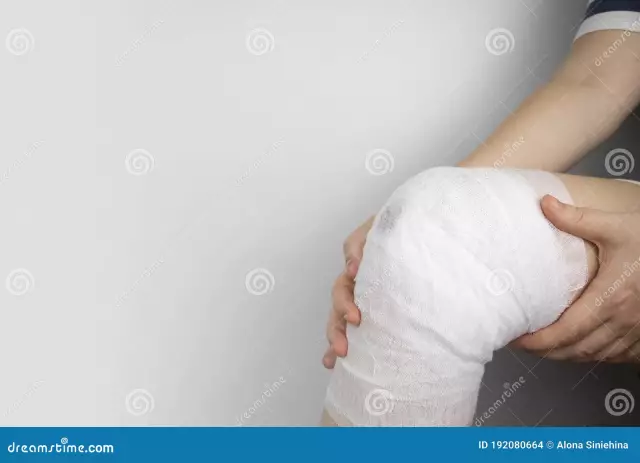- Author Curtis Blomfield [email protected].
- Public 2023-12-16 20:44.
- Last modified 2025-01-23 17:01.
The compression effect is based on the effect of compression, which creates pressure on certain parts of the limbs. This therapy dates back to the Middle Ages, where laced stockings were used to squeeze the legs, which regulated the force of contraction. Currently, appropriate underwear or special elastic bandages made on the basis of latex are used for compression.
What are compression bandages for
Compression dressing is an elastic bandage used to create compensatory pressure on the limbs in order to prevent or eliminate destructive changes in the veins. This technique is used to treat:
- edema of post-traumatic etiology;
- cellulite;
- varicose veins.
During some operations, bandages based on these bandages are used to prevent accidental entry of air into the veins. Compression also reduces the likelihood of thrombus formation after surgery.intervention.

Compression bandages can be used not only by patients, but also by ordinary people for preventive purposes. This method is recommended for some athletes, as well as for those who are on their feet for a long time. In this case, even in a he althy person, there is excessive tension in the lower extremities, which can lead to edema and obstruction of the outflow of blood and lymph. By compensating for pressure, compression eliminates this problem, helping to relieve pressure on the veins and facilitate the work of muscle tissue.
Composition and main features
There are three types of materials in the compression bandage:
- polyester;
- cotton;
- elastic (most often latex).
The ability of the dressing tape to stretch and compress depends on the ratio of these components.
Operation principle
Each type of compression bandage material has its own function. So, latex threads provide extensibility, due to which the pressure on the limb during dressing is unevenly distributed. This makes it possible to improve blood circulation and prevent the formation of varicose edema. With the correct application technique, a compression bandage creates maximum pressure in the lower part of the limb and minimal pressure in the upper.

Cotton surrounds the elastic component, acting as a sheathing that prevents skin from contacting synthetics. The layer of natural fabric preventsrubbing and absorbs sweat well. In addition, cotton makes the bandage soft.
Polyester fiber gives the compression band strength and durability. Thanks to this component, the bandage is resistant to mechanical stress and is able to withstand repeated washings without losing the therapeutic effect. The polyester component allows the use of a bandage for fixing purposes.
Due to its elasticity, the compression bandage does not interfere with joint mobility and does not squeeze blood vessels. In addition, such a bandage is almost invisible under clothing. Another advantage of the compression tape is its wear resistance and the possibility of repeated washing.
Sizes
The maximum length of an elastic compression bandage is 5 meters, and the minimum is one and a half. The width varies from 8 to 10 cm. This parameter affects the force of compression of the limb. The wider the bandage, the stronger the pressure exerted by the bandage. However, the effect of blocking blood flow is reduced. The width of the dressing tape is selected depending on the size of the limbs. The maximum length of an elastic compression bandage (5 m) is much less common than the standard, which is 2.5-3 meters.

It is worth noting that due to the special structure, the dressing tape does not change width when stretched.
Varieties
There are three types of compression bandages according to the ability to longitudinal deformation:
- short extensibility - can increase their length by 40-70% of the initial;
- medium stretch -lengthen in the range from 100 to 140%;
- long tensile - deformability exceeds 140%.

The degree of elongation of the bandage depends on the percentage of elastic and inelastic components in the composition. Using bandages of different extensibility, you can adjust the stiffness of the compression of the limb. According to the type of bandage used, compression is divided into:
- high (short-stretch material) - used for severe thrombosis and pathological changes in the skin of a dystrophic nature, as well as for fixing joints after injuries and operations;
- medium (medium stretch bandage) - used for venous insufficiency and after sclerotherapy;
- small (the most extensible material) - used for prophylactic purposes, for a bandage for dislocations and sprains, as well as for severe venous insufficiency.
Low compression is characterized by the most even distribution of pressure over the limb. This bandage improves blood circulation, while not restricting movement. This is the softest version of the compression bandage.
However, despite the advantages of a bandage of long extensibility, the pressure created by it does not have the proper therapeutic effect with increased loads on the limbs. Therefore, in such cases, high and medium compression is more often used.






